Predictive Modeling of Reservoir Quality Associated with the Dissolution of K-Feldspar During Diagenesis: Lower Cretaceous, Scotian Basin, Canada
Abstract
1. Introduction
2. Geological Setting
2.1. Stratigraphy
2.2. Sediment Facies and Architecture
2.3. Provenance of Detrital Sediment
2.4. Overview of Diagenesis
2.5. Diagenesis of Feldspars
2.6. The Origins of Secondary Porosity
3. Materials and Methods
3.1. Modeling Strategy and Principles of Forward Stratigraphic Modeling by DionisosFlowTM
3.2. Sampling Strategy
3.3. Feldspar Analysis
4. Results
4.1. Feldspar Analysis
4.1.1. K-Feldspar Proportion
4.1.2. Grain Size Analysis
4.2. Model Methodology and Results
4.2.1. Upper Missisauga Formation
4.2.2. Naskapi Member
4.2.3. Cree Member
5. Discussion
5.1. Controls on the K-Feldspar Proportion
5.1.1. Influence of Provenance
5.1.2. Influence of Climate
5.1.3. Influence of Burial and Diagenesis
5.1.4. Variations in Grain Size
5.1.5. Grain Size Shift
5.2. K-Feldspar Distribution Model
5.2.1. K-Feldspar Distribution
5.2.2. Evaluation of the Risks Due to Reservoir Quality
5.2.3. Predicting the Generation of Secondary Porosity from Feldspar Dissolution
5.2.4. Open vs. Closed System
5.2.5. Common-Risk-Segment Maps Based on the Distributions of Sand, K-Feldspar, and Secondary Porosity
6. Conclusions
Author Contributions
Funding
Data Availability Statement
Acknowledgments
Conflicts of Interest
Abbreviations
| CRS | Common risk segment |
References
- Schmoker, J.W.; Gautier, D.L. Sandstone porosity as a function of thermal maturity. Geology 1988, 16, 1007–1010. [Google Scholar] [CrossRef]
- Schmoker, J.W.; Schenk, C.J. Regional porosity trends of the Upper Jurassic Norphlet Formation in southwestern Alabama and vicinity, with comparisons to formations of other basins. AAPG Bull. 1994, 78, 166–180. [Google Scholar] [CrossRef]
- Ehrenberg, S.N.; Nadeau, P.H.; Steen, Ø. A megascale view of reservoir quality in producing sandstones from the offshore Gulf of Mexico. AAPG Bull. 2008, 92, 145–164. [Google Scholar] [CrossRef]
- Taylor, T.R.; Giles, M.R.; Hathon, L.A.; Diggs, T.N.; Braunsdorf, N.R.; Birbiglia, G.V.; Kittridge, M.G.; Macaulay, C.I.; Espejo, I.S. Sandstone diagenesis and reservoir quality prediction: Models, myths, and reality. AAPG Bull. 2010, 94, 1093–1132. [Google Scholar] [CrossRef]
- Taylor, T.R. Association of allochthonous waters and reservoir enhancement in deeply buried Miocene sandstones: Picaroon field, Corsair trend, offshore Texas. In Siliciclastic Diagenesis and Fluid Flow: Concepts and Applications; Crossey, L.J., Loucks, R., Totten, M.W., Eds.; SEPM Special Publication; Society for Sedimentary Geology (SEPM): Claremore, OK, USA, 1996; Volume 55, pp. 37–48. [Google Scholar]
- Zhu, S.; Zhu, X.; Wang, X.; Liu, Z. Zeolite diagenesis and its control on petroleum reservoir quality of Permian in northwestern margin of Junggar Basin, China. Sci. China Earth Sci. 2012, 55, 386–396. [Google Scholar] [CrossRef]
- Morad, S.; Al-Ramadan, K.; Ketzer, J.M.; De Ros, L.F. The impact of diagenesis on the heterogeneity of sandstone reservoirs: A review of the role of depositional facies and sequence stratigraphy. AAPG Bull. 2010, 94, 1267–1309. [Google Scholar] [CrossRef]
- Haszeldine, R.S.; Wilkinson, M.; Darby, D.; Macaulay, C.I.; Couples, G.D.; Fallick, A.E.; Fleming, C.G.; Stewart, R.N.; McAulay, G. Diagenetic porosity creation in an overpressured graben. Geol. Soc. Lond. Pet. Geol. Conf. Ser. 1999, 5, 1339–1350. [Google Scholar] [CrossRef]
- Walker, T.R. SEPM presidential address; Diagenetic albitization of potassium feldspar in arkosic sandstones. J. Sedim. Res. 1984, 54, 3–16. [Google Scholar]
- Chuhan, F.A.; Bjørlykke, K.; Lowrey, C.J. Closed-system burial diagenesis in reservoir sandstones: Examples from the Garn Formation at Haltenbanken area, offshore mid-Norway. J. Sedim. Res. 2001, 71, 15–26. [Google Scholar] [CrossRef]
- González-Acebrón, L.; Arribas, J.; Mas, R. Role of sandstone provenance in the diagenetic albitization of feldspars: A case study of the Jurassic Tera Group sandstones (Cameros Basin, NE Spain). Sedim. Geol. 2010, 229, 53–63. [Google Scholar] [CrossRef]
- Yuan, G.; Cao, Y.; Gluyas, J.; Li, X.; Xi, K.; Wang, Y.; Jia, Z.; Sun, P.; Oxtoby, N.H. Feldspar dissolution, authigenic clays, and quartz cements in open and closed sandstone geochemical systems during diagenesis: Typical examples from two sags in Bohai Bay Basin, East China. AAPG Bull. 2015, 99, 2121–2154. [Google Scholar] [CrossRef]
- Wilkinson, M.; Milliken, K.L.; Haszeldine, R.S. Systematic destruction of K-feldspar in deeply buried rift and passive margin sandstones. J. Geol. Soc. 2001, 158, 675–683. [Google Scholar] [CrossRef]
- Wilkinson, M.; Darby, D.; Haszeldine, R.S.; Couples, G.D. Secondary porosity generation during deep burial associated with overpressure leak-off: Fulmar Formation, United Kingdom Central Graben. AAPG Bull. 1997, 81, 803–813. [Google Scholar] [CrossRef]
- Zhu, X.M.; Zhong, D.K.; Zhang, Q.; Zhang, L. Sandstone diagenesis and porosity evolution of Paleogene in Huimin depression. Petrol. Sci. 2004, 3, 23–29. [Google Scholar]
- Giles, M.R.; De Boer, R.B. Origin and significance of redistributional secondary porosity. Mar. Petrol. Geol. 1990, 7, 378–397. [Google Scholar] [CrossRef]
- Higgs, K.E.; Zwingmann, H.; Reyes, A.G.; Funnell, R.H. Diagenesis, porosity evolution, and petroleum emplacement in tight gas reservoirs, Taranaki Basin, New Zealand. J. Sedim. Res. 2007, 77, 1003–1025. [Google Scholar] [CrossRef]
- Hawie, N.; Deschamps, R.; Granjeon, D.; Nader, F.H.; Gorini, C.; Müller, C.; Montadert, L.; Baudin, F. Multi-scale constraints of sediment source to sink systems in frontier basins: A forward stratigraphic modelling case study of the Levant region. Basin Res. 2017, 29, 418–445. [Google Scholar] [CrossRef]
- Hawie, N.; Covault, J.A.; Dunlap, D.; Sylvester, Z. Slope-fan depositional architecture from high-resolution forward stratigraphic models. Mar. Petrol. Geol. 2018, 91, 576–585. [Google Scholar] [CrossRef]
- Hawie, N.; Marfisi, E.; Saint-Ange, F.; MacDonald, A.W.A. Statistical analysis of forward stratigraphic models in complex salt provinces: The central Scotian Basin case study. AAPG Bull. 2019, 103, 433–467. [Google Scholar] [CrossRef]
- Grohmann, S.; Fietz, W.S.; Nader, F.H.; Romero-Sarmiento, M.F.; Baudin, F.; Littke, R. Characterization of Late Cretaceous to Miocene source rocks in the Eastern Mediterranean Sea: An integrated numerical approach of stratigraphic forward modelling and petroleum system modelling. Basin Res. 2021, 33, 846–874. [Google Scholar] [CrossRef]
- Sheldon, H.A.; Crombez, V.; Poulet, T.; Kelka, U.; Kunzmann, M.; Kerrison, E. Realistic permeability distributions in faults and sediments: The key to predicting fluid flow in sedimentary basins. Basin Res. 2023, 35, 2118–2139. [Google Scholar] [CrossRef]
- Blowick, A.; Pe-Piper, G.; Piper, D.J.W.; Zhang, Y.; Tyrrell, S. First-cycle sand supply and the evolution of the eastern Canadian continental margin: Insights from Pb isotopes in the Mesozoic Scotian Basin. GSA Bull. 2021, 133, 1301–1319. [Google Scholar] [CrossRef]
- Wach, G.D.; Brown, D.E. Petroleum exploration on the Scotian Margin. In Proceedings of the GeoConvention, Virtual, 13–15 September 2021; Available online: https://geoconvention.com/wp-content/uploads/abstracts/2021/67693-petroleum-exploration-on-the-scotian-margin.pdf (accessed on 17 September 2025).
- OETR (Offshore Energy Technical Research Association). Play Fairway Analysis Atlas–Offshore Nova Scotia: Nova Scotia Department of Energy, 88-11-0004-01. 2011. 349p. Available online: https://energy.novascotia.ca/oil-and-gas/offshore/play-fairway-analysis (accessed on 9 September 2025).
- Pe-Piper, G.; Piper, D.J.W. Temperature and basinal fluid controls on feldspar diagenesis, Lower Cretaceous sandstones, Scotian Basin, Canada. Mar. Petrol. Geol. 2022, 141, 105704. [Google Scholar] [CrossRef]
- Kidston, A.G.; Smith, B.; Brown, D.E.; Makrides, C.; Altheim, B. Nova Scotia Deep Water Offshore Post-Drill Analysis 1982–2004; Canada-Nova Scotia Offshore Petroleum Board: Halifax, NS, Canada, 2007; 181p. [Google Scholar]
- Sangster, C.; Piper, D.J.W.; Hawie, N.; Pe-Piper, G.; Saint-Ange, F. Forward stratigraphic modelling of sediment pathways and depocentres in salt-influenced passive-margin basins: Lower Cretaceous, central Scotian Basin. Basin Res. 2019, 31, 728–753. [Google Scholar] [CrossRef]
- Zhang, Y.; Pe-Piper, G.; Piper, D.J.W. Sediment geochemistry as a provenance indicator: Unravelling the cryptic signatures of polycyclic sources, climate change, tectonism and volcanism. Sedimentology 2014, 61, 383–410. [Google Scholar] [CrossRef]
- Gould, K.; Pe-Piper, G.; Piper, D.J.W. Relationship of diagenetic chlorite rims to depositional facies in Lower Cretaceous reservoir sandstones of the Scotian Basin. Sedimentology 2010, 57, 587–610. [Google Scholar] [CrossRef]
- Karim, A.; Pe-Piper, G.; Piper, D.J.W. Controls on diagenesis of Lower Cretaceous reservoir sandstones in the western Sable Subbasin, offshore Nova Scotia. Sedim. Geol. 2010, 224, 65–83. [Google Scholar] [CrossRef]
- Pe-Piper, G.; Piper, D.J.W. Significance of the chemistry and morphology of diagenetic siderite in clastic rocks of the Mesozoic Scotian Basin. Sedimentology 2019, 67, 782–809. [Google Scholar] [CrossRef]
- Zhang, Y.; Pe-Piper, G.; Piper, D.J.W. How sandstone porosity and permeability vary with diagenetic minerals in the Scotian Basin, offshore eastern Canada: Implications for reservoir quality. Mar. Petrol. Geol. 2015, 63, 28–45. [Google Scholar] [CrossRef]
- Weston, J.F.; MacRae, R.A.; Ascoli, P.; Cooper, M.K.E.; Fensome, R.A.; Shaw, D.; Williams, G.L. A revised biostratigraphic and well-log sequence-stratigraphic framework for the Scotian Margin, offshore eastern Canada. Can. J. Earth Sci. 2012, 49, 1417–1462. [Google Scholar] [CrossRef]
- Pe-Piper, G. Reservoir Quality and Sediment Delivery, Mesosoic Scotian Basin. Unpublished report; Encana, NSERC and OERA: Calgary, AB, Canada, 2016; 125p. [Google Scholar]
- Wade, J.; MacLean, B. The geology of the southeastern margin of Canada. In Geology of the Continental Margin of Eastern Canada; Keen, M.J., Williams, G.L., Eds.; Geology of Canada; Geological Survey of Canada: Ottawa, ON, Canada, 1990; Volume 2, pp. 167–238. [Google Scholar]
- IFP Energies Nouvelles. BeicipFranlab, DionisosFlow Software. 2016. Available online: http://www.beicip.com/stratigraphic-modelling-0 (accessed on 9 September 2025).
- Granjeon, D. 3D forward modelling of the impact of sediment transport and base level cycles on continental margins and incised valleys. In From Depositional Systems to Sedimentary Successions on the Norwegian Continental Margin; Martinius, A.W., Ravnås, R., Howell, J.A., Steel, R.J., Wonham, J.P., Eds.; International Association of Sedimentology Special Publication; Wiley: Hoboken, NJ, USA, 2014; Volume 46, pp. 453–472. [Google Scholar] [CrossRef]
- Ings, S.J.; Shimeld, J.W. A new conceptual model for the structural evolution of a regional salt detachment on the northeast Scotian margin, offshore eastern Canada. AAPG Bull. 2006, 90, 1407–1423. [Google Scholar] [CrossRef]
- Kendell, K.L. Variations in salt expulsion style within the Sable canopy complex, central Scotian margin. Can. J. Earth Sci. 2012, 49, 1504–1522. [Google Scholar]
- Deptuck, M.E.; Kendell, K.L. A review of Mesozoic-Cenozoic salt tectonics along the Scotian margin, eastern Canada. In Permo-Triassic Salt Provinces of Europe, North Africa and the Atlantic Margins; Soto, J.I., Flinch, J.F., Tari, G., Eds.; Elsevier: Amsterdam, The Netherlands, 2017; pp. 287–312. [Google Scholar] [CrossRef]
- Piper, D.J.W.; Noftall, R.; Pe-Piper, G. Allochthonous prodeltaic sediment facies in the Lower Cretaceous at the Tantallon M-41 well: Implications for the deep-water Scotian Basin. AAPG Bull. 2010, 94, 87–104. [Google Scholar] [CrossRef]
- Chavez, I.; Piper, D.J.W.; Pe-Piper, G. Correlation of the Aptian Naskapi Member of the Scotian Basin and its regional implications. Can. J. Earth Sci. 2018, 55, 514–535. [Google Scholar] [CrossRef]
- Cummings, D.I.; Arnott, R.W.C. Growth-faulted shelf-margin deltas: A new (but old) play type, offshore Nova Scotia. Bull. Can. Petrol. Geol. 2005, 53, 211–236. [Google Scholar] [CrossRef]
- Deptuck, M.E.; Kendell, K.; Brown, D.E.; Smith, B.M. Seismic Stratigraphic Framework and Structural Evolution of the Eastern Scotian Slope: Geological Context for the NS14-1 Call for Bids Area, Offshore Nova Scotia; Geoscience Open File Report; Canada-Nova Scotia Offshore Petroleum Board: Halifax, NS, Canada, 2014. [Google Scholar]
- CNSOPB. Technical Summaries of Scotian Shelf Significant and Commercial Discoveries. 2000. Available online: https://callforbids.cnsopb.ns.ca/2008/02/Publications/Geoscience/Technical%20Summaries.pdf (accessed on 17 September 2025).
- Pe-Piper, G.; Piper, D.J.W.; Zhang, Y.; Chavez, I. Diagenetic barite and sphalerite in middle Mesozoic sandstones, Scotian Basin, as tracers for basin hydrology. AAPG Bull. 2015, 99, 1281–1313. [Google Scholar] [CrossRef]
- Reynolds, P.H.; Pe-Piper, G.; Piper, D.J.W. Detrital muscovite geochronology and the Cretaceous tectonics of the inner Scotian Shelf, southeastern Canada. Can. J. Earth Sci. 2012, 49, 1558–1566. [Google Scholar] [CrossRef]
- Tsikouras, B.; Pe-Piper, G.; Piper, D.J.W.; Schaffer, M. Varietal heavy mineral analysis of sediment provenance, Lower Cretaceous Scotian Basin, eastern Canada. Sedim. Geol. 2011, 237, 150–165. [Google Scholar] [CrossRef]
- Piper, D.J.W.; Pe-Piper, G.; Tubrett, M.; Triantafyllidis, S.; Strathdee, G. Detrital zircon geochronology and polycyclic sediment sources, Upper Jurassic-Lower Cretaceous of the Scotian Basin, southeastern Canada. Can. J. Earth Sci. 2012, 49, 1540–1557. [Google Scholar] [CrossRef]
- Pe-Piper, G.; Piper, D.J.W.; Triantafyllidis, S. Detrital monazite geochronology, Upper Jurassic-Lower Cretaceous of the Scotian Basin: Significance for tracking first-cycle sources. Geol. Soc. Lond. Spec. Publ. 2014, 386, 293–311. [Google Scholar] [CrossRef]
- Sales de Oliveira, C.E.; Pe-Piper, G.; Piper, D.J.W.; Zhang, Y.; Corney, R. Integrated methodology for determining provenance of detrital quartz using optical petrographic microscopy and cathodoluminescence (CL) properties. Mar. Petrol. Geol. 2017, 88, 41–53. [Google Scholar]
- Okwese, A.C.; Pe-Piper, G.; Piper, D.J.W. Controls on regional variability in marine pore-water diagenesis below the seafloor in Upper Jurassic–Lower Cretaceous prodeltaic sandstone and shales, Scotian Basin, Eastern Canada. Mar. Petrol. Geol. 2012, 29, 175–191. [Google Scholar]
- Karim, A.; Hanley, J.J.; Pe-Piper, G.; Piper, D.J.W. Paleohydrogeological and thermal events recorded by fluid inclusions and stable isotopes of diagenetic minerals in Lower Cretaceous sandstones, offshore Nova Scotia, Canada. AAPG Bull. 2012, 96, 1147–1169. [Google Scholar] [CrossRef]
- Bowman, S.J.; Pe-Piper, G.; Piper, D.J.W.; Fensome, R.A.; King, E.L. Early Cretaceous volcanism in the Scotian Basin. Can. J. Earth Sci. 2012, 49, 1523–1539. [Google Scholar] [CrossRef]
- Grist, A.; Reynolds, P.H.; Zentilli, M.; Beaumont, C. The Scotian Basin offshore Nova Scotia: Thermal history and provenance of sandstones from apatite fission track and 40Ar/39Ar data. Can. J. Earth Sci. 1992, 29, 909–924. [Google Scholar] [CrossRef]
- Pe-Piper, G.; Sangster, C.; Zhang, Y. Diagenetic F-rich ferroan calcite and zircon in the offshore Scotian Basin, eastern Canada: Significance for understanding thermal evolution of the basin. Am. Mineral. 2017, 102, 1542–1555. [Google Scholar]
- Grant, S.; Milton, N.; Thompson, M. Play fairway analysis and risk mapping: An example using the Middle Jurassic Brent group in the northern North Sea. Nor. Pet. Soc. Spec. Publ. 1996, 6, 167–181. [Google Scholar]
- Granjeon, D. Modelisation Stratigraphique Deterministe—Conception et Applications d’un Modele Diffusif 3D Multi-Lithologique. Ph.D. Thesis, Université de Rennes 1, Rennes, France, 1996. [Google Scholar]
- Deville, E.; Mascle, A.; Callec, Y.; Huyghe, P.; Lallemant, S.; Lerat, O.; Mathieu, X.; De Carillo, C.P.; Patriat, M.; Pichot, T. Tectonics and sedimentation interactions in the east Caribbean subduction zone: An overview from the Orinoco delta and the Barbados accretionary prism. Mar. Petrol. Geol. 2015, 64, 76–103. [Google Scholar] [CrossRef]
- Sangster, C. Provenance and Diagenesis of the Lower Cretaceous to Middle Jurassic Sandstones in the Slope Well Newburn H-23, Scotian Slope. B.Sc. Honours Thesis, Saint Mary’s University, Halifax, NS, Canada, 2016. Available online: https://library2.smu.ca/handle/01/26523 (accessed on 17 September 2025).
- Tovey, N.K.; Krinsley, D.H. Mapping of the orientation of fine-grained minerals in soils and sediments. Bull. Internat. Assoc. Engin. Geol. 1992, 46, 93–101. [Google Scholar]
- Corel. CorelDraw X7 and X3. 2016. Available online: https://www.coreldraw.com/en/ (accessed on 13 July 2019).
- PRF (Purdue Research Foundation). MultiSpec Image Data Analysis System. 2016. Available online: https://engineering.purdue.edu/~biehl/MultiSpec/ (accessed on 9 September 2025).
- NIH (National Institutes of Health). ImageJ Image Analysis Software. 2019. Available online: https://imagej.net/ij/disclaimer.html (accessed on 9 September 2025).
- Ruffell, A.H.; Batten, D.J. The Barremian-Aptian arid phase in western Europe. Palaeogeog. Palaeoclim. Palaeoecol. 1990, 80, 197–212. [Google Scholar]
- Ruffell, A.; Worden, R. Paleoclimate analysis using spectral gamma-ray data from the Aptian (Cretaceous) of southern England and southern France. Palaeogeog. Palaeoclim. Palaeoecol. 2000, 155, 265–283. [Google Scholar] [CrossRef]
- Gould, K.M.; Piper, D.J.W.; Pe-Piper, G.; MacRae, R.A. Facies, provenance and paleoclimate interpretation using spectral gamma logs: Application to the Lower Cretaceous of the Scotian Basin. Mar. Petrol. Geol. 2014, 57, 445–454. [Google Scholar] [CrossRef]
- Chavez, I.; Piper, D.J.W.; Pe-Piper, G.; Zhang, Y. North Atlantic climatic events recorded in Aptian Naskapi Member cores, Scotian Basin. Cret. Res. 2016, 60, 297–307. [Google Scholar] [CrossRef]
- Föllmi, K.B. Early Cretaceous life, climate and anoxia. Cret. Res. 2012, 35, 230–257. [Google Scholar] [CrossRef]
- Karim, A.; Pe-Piper, G.; Piper, D.J.W.; Hanley, J.J. Thermal and hydrocarbon-charge history and the relationship between diagenesis and reservoir connectivity: Venture field, offshore Nova Scotia, eastern Canada. Can. J. Earth Sci. 2011, 48, 1293–1306. [Google Scholar] [CrossRef]
- Issler, D.R. Calculation of organic maturation levels for offshore eastern Canada—Implications for general application of Lopatin’s method. Can. J. Earth Sci. 1984, 21, 477–488. [Google Scholar] [CrossRef]
- Bjørlykke, K.; Jahren, J. Open or closed geochemical systems during diagenesis in sedimentary basins: Constraints on mass transfer during diagenesis and the prediction of porosity in sandstone and carbonate reservoirs. AAPG Bull. 2012, 96, 2193–2214. [Google Scholar] [CrossRef]
- Bjørlykke, K. Clay mineral diagenesis in sedimentary basins—A key to the prediction of rock properties, Examples from the North Sea Basin. Clay Miner. 1998, 33, 15–34. [Google Scholar] [CrossRef]
- Lanson, B.; Beaufort, D.; Berger, G.; Bauer, A.; Cassagnabère, A.; Meunier, A. Authigenic kaolin and illitic minerals during burial diagenesis of sandstones: A review. Clay Miner. 2002, 37, 1–22. [Google Scholar] [CrossRef]
- Franks, S.G.; Zwingmann, H. Origin and timing of late diagenetic illite in the Permian–Carboniferous Unayzah sandstone reservoirs of Saudi Arabia. AAPG Bull. 2010, 94, 1133–1159. [Google Scholar] [CrossRef]
- Aagaard, P.; Egeberg, P.K.; Saigal, G.C.; Morad, S.; Bjorlykke, K. Diagenetic albitization of detrital K-feldspars in Jurassic, Lower Cretaceous and Tertiary clastic reservoir rocks from offshore Norway; II, Formation water chemistry and kinetic considerations. J. Sedim. Res. 1990, 60, 575–581. [Google Scholar] [CrossRef]
- Saigal, G.C.; Morad, S.; Bjorlykke, K.; Egeberg, P.K.; Aagaard, P. Diagenetic albitization of detrital K-feldspar in Jurassic, Lower Cretaceous, and Tertiary clastic reservoir rocks from offshore Norway; I, Textures and origin. J. Sedim. Res. 1988, 58, 1003–1013. [Google Scholar]
- Odom, I.E.; Doe, T.W.; Dott, R.H. Nature of feldspar-grain size relations in some quartz-rich sandstones. J. Sedim. Res. 1976, 46, 862–870. [Google Scholar]
- Blatt, H.; Middleton, G.; Murray, R. Origin of Sedimentary Rocks; Prentice-Hall: Englewood Cliffs, NJ, USA, 1972; 576p. [Google Scholar]
- Nesbitt, H.W.; Young, G.M. Petrogenesis of sediments in the absence of chemical weathering: Effects of abrasion and sorting on bulk composition and mineralogy. Sedimentology 1996, 43, 341–358. [Google Scholar] [CrossRef]
- Garzanti, E.; Andò, S.; Vezzoli, G. Settling equivalence of detrital minerals and grain-size dependence of sediment composition. Earth Planet. Sci. Lett. 2008, 273, 138–151. [Google Scholar] [CrossRef]
- OERA (Offshore Energy Research Association). Central Scotian Slope Atlas. 2016. Available online: https://oera.ca/research/central-scotian-slope-atlas-2016 (accessed on 9 September 2025).
- Deptuck, M.E.; Kendell, K.; Smith, B. Complex deepwater fold belts in the SW Sable Subbasin, offshore Nova Scotia (abs.). In Proceedings of the Canadian Society of Petroleum Geologists/Canadian Society of Exploration Geophysicists/Canadian Well Logging Society Convention, Calgary, AB, Canada, 4–8 May 2009. [Google Scholar]
- Gould, K.M.; Karim, A.; Piper, D.J.W.; Pe-Piper, G. Lithofacies and Diagenesis of Selected Conventional Core from Jurassic and Early Cretaceous Terrigenous Clastic Rocks, Scotian Basin; Geological Survey of Canada Open File 6945; Natural Resources Canada: Ottawa, ON, Canada, 2011; 272p. [Google Scholar] [CrossRef]
- Tobin, R.C.; Schwarzer, D. Effects of sandstone provenance on reservoir quality preservation in the deep subsurface: Experimental modelling of deep-water sand in the Gulf of Mexico. Geol. Soc. Lond. Spec. Publ. 2014, 386, 27–47. [Google Scholar] [CrossRef]
- Ajdukiewicz, J.M.; Nicholson, P.H.; Esch, W.L. Prediction of deep reservoir quality using early diagenetic process models in the Jurassic Norphlet Formation, Gulf of Mexico. AAPG Bull. 2010, 94, 1189–1227. [Google Scholar] [CrossRef]
- Sangster, C. Application of Predictive Modeling to the Lower Cretaceous Sedimentary Sequences of the Central Scotian Basin. Master’s Thesis, Saint Mary’s University, Halifax, NS, Canada, 2019. Available online: https://library2.smu.ca/handle/01/29128 (accessed on 17 September 2025).
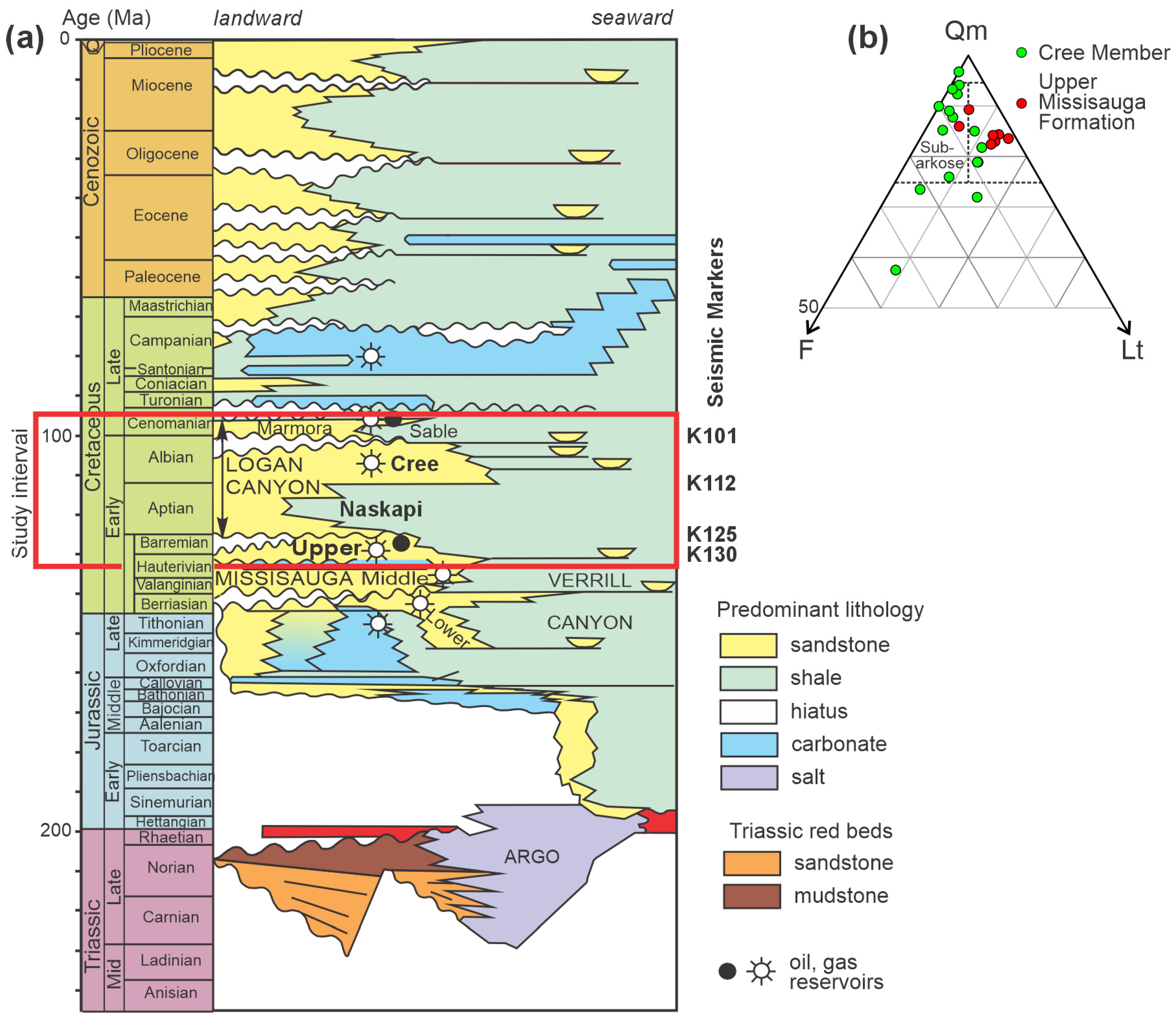
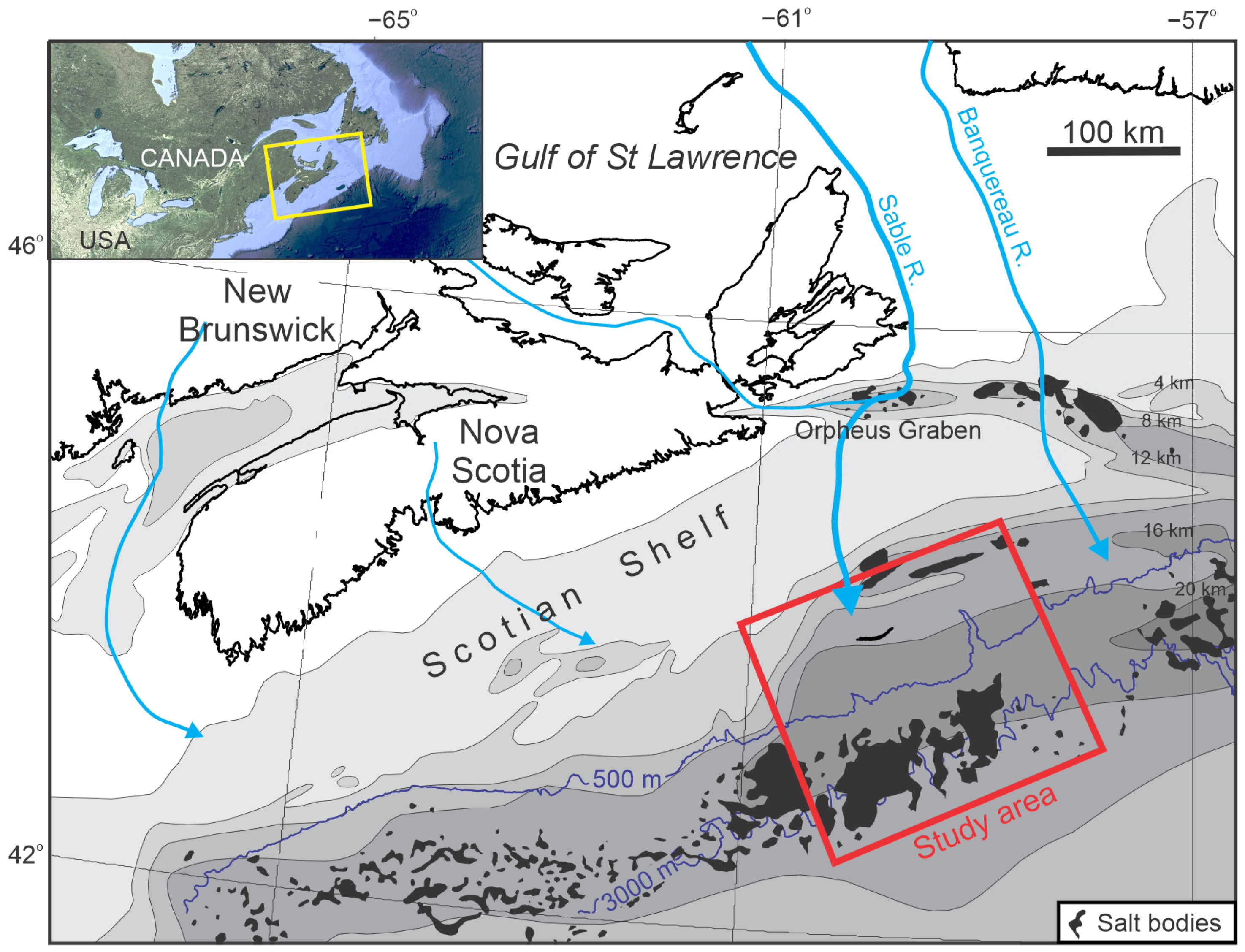


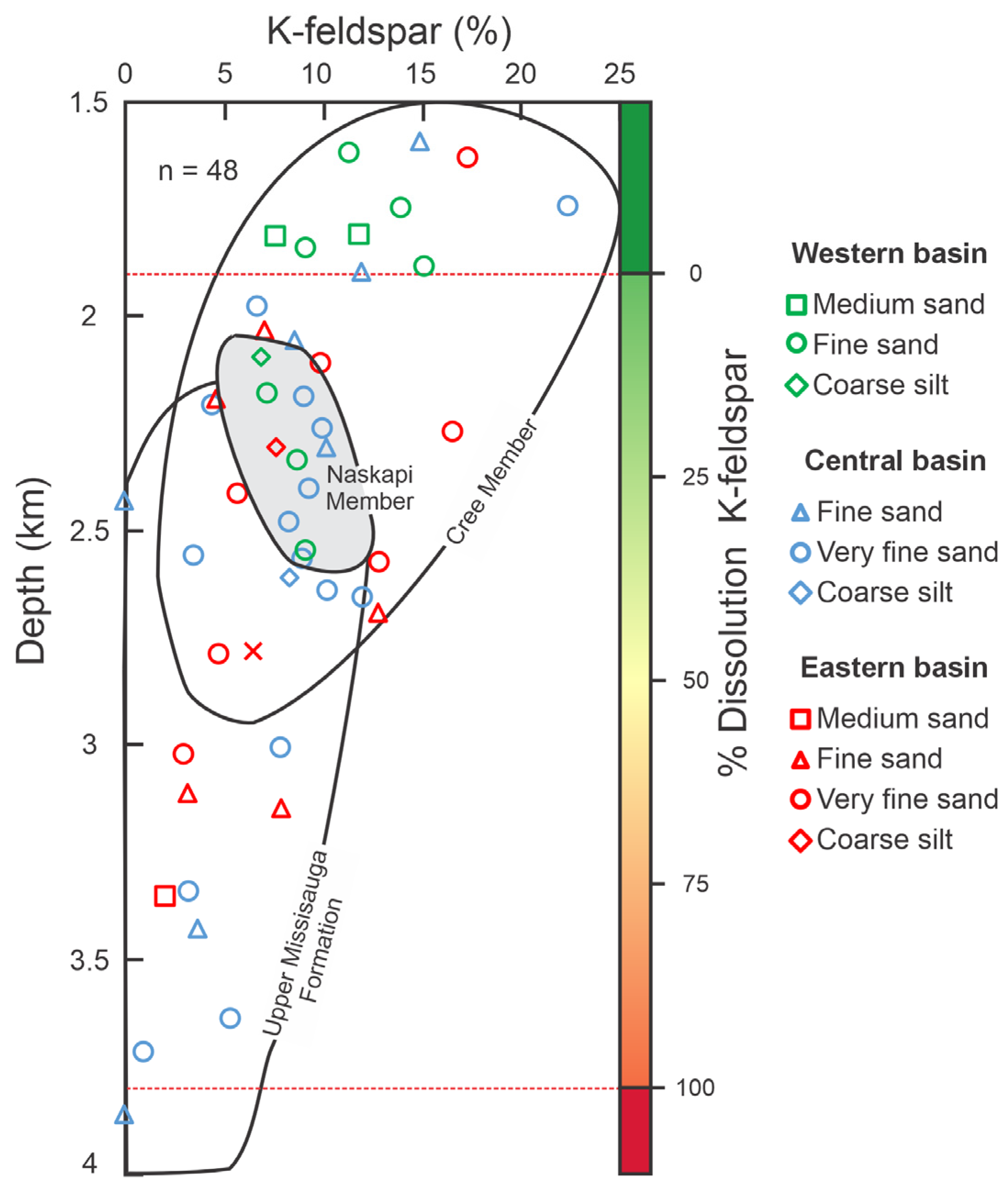
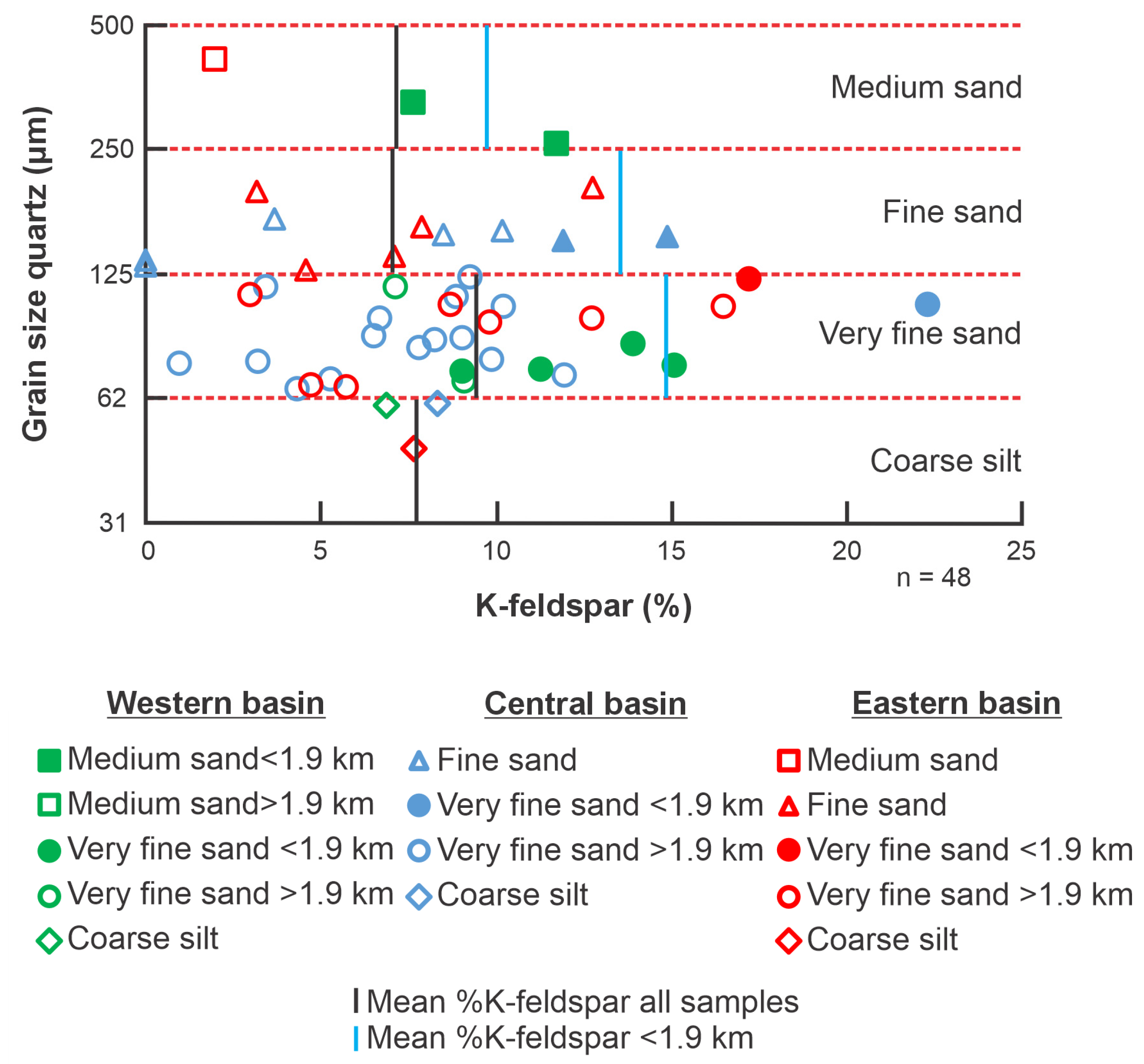
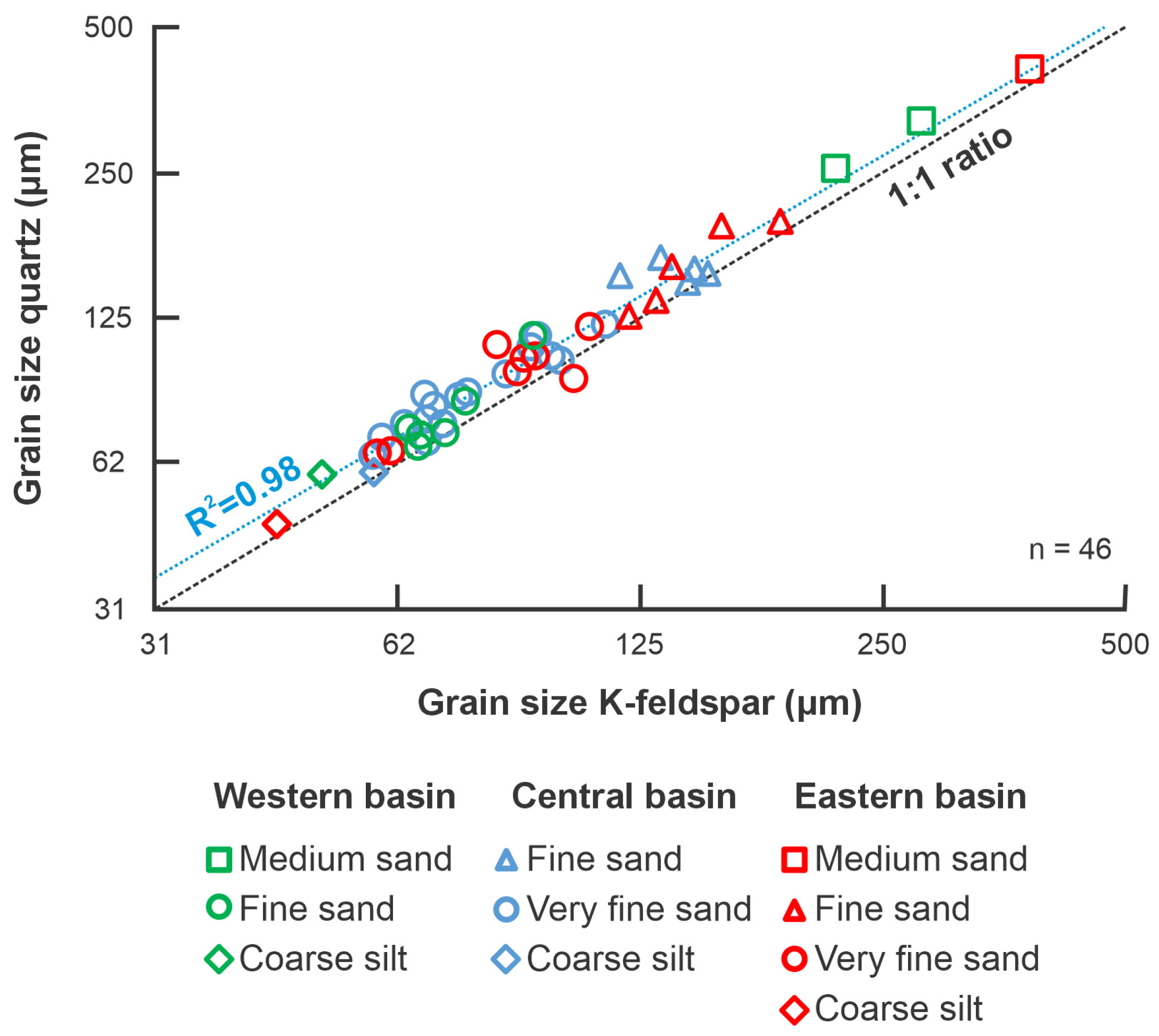
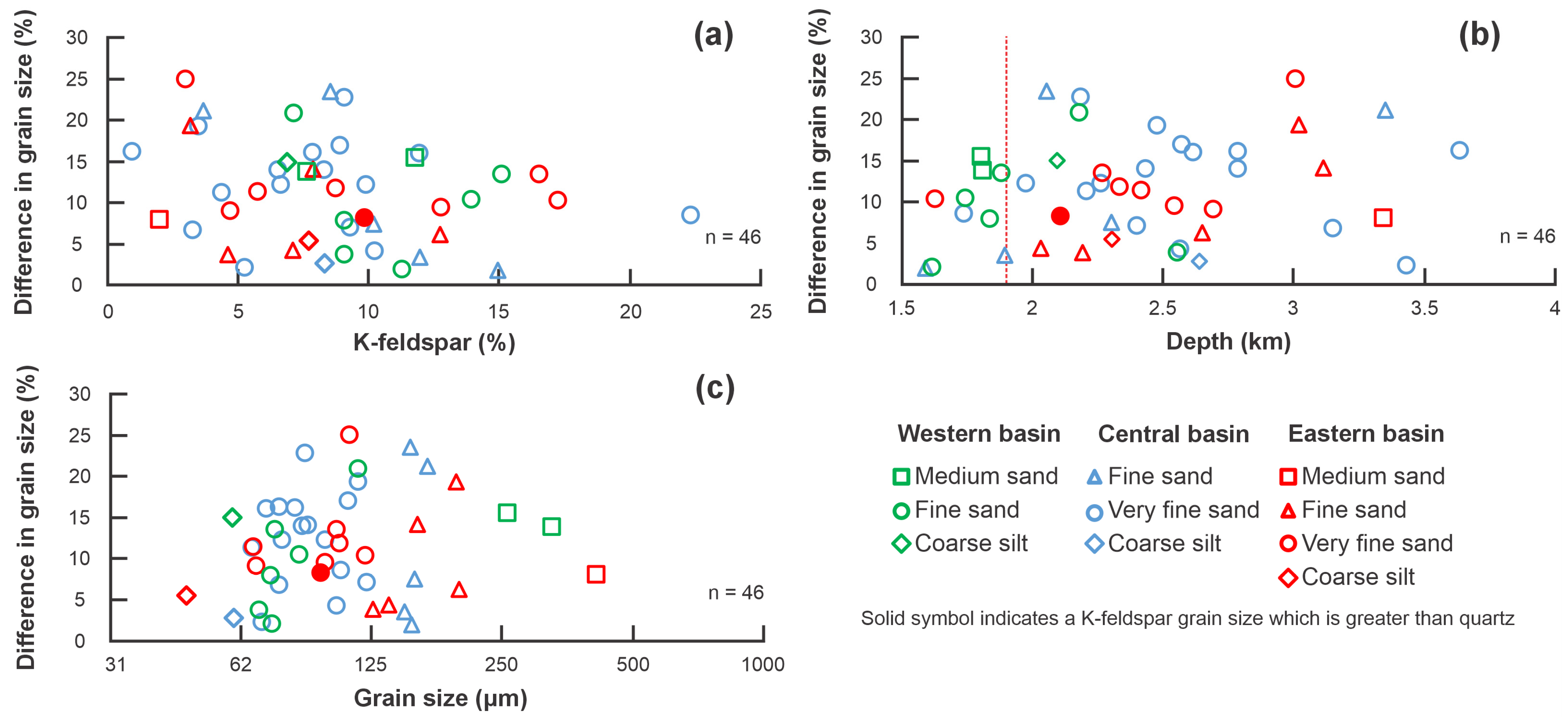
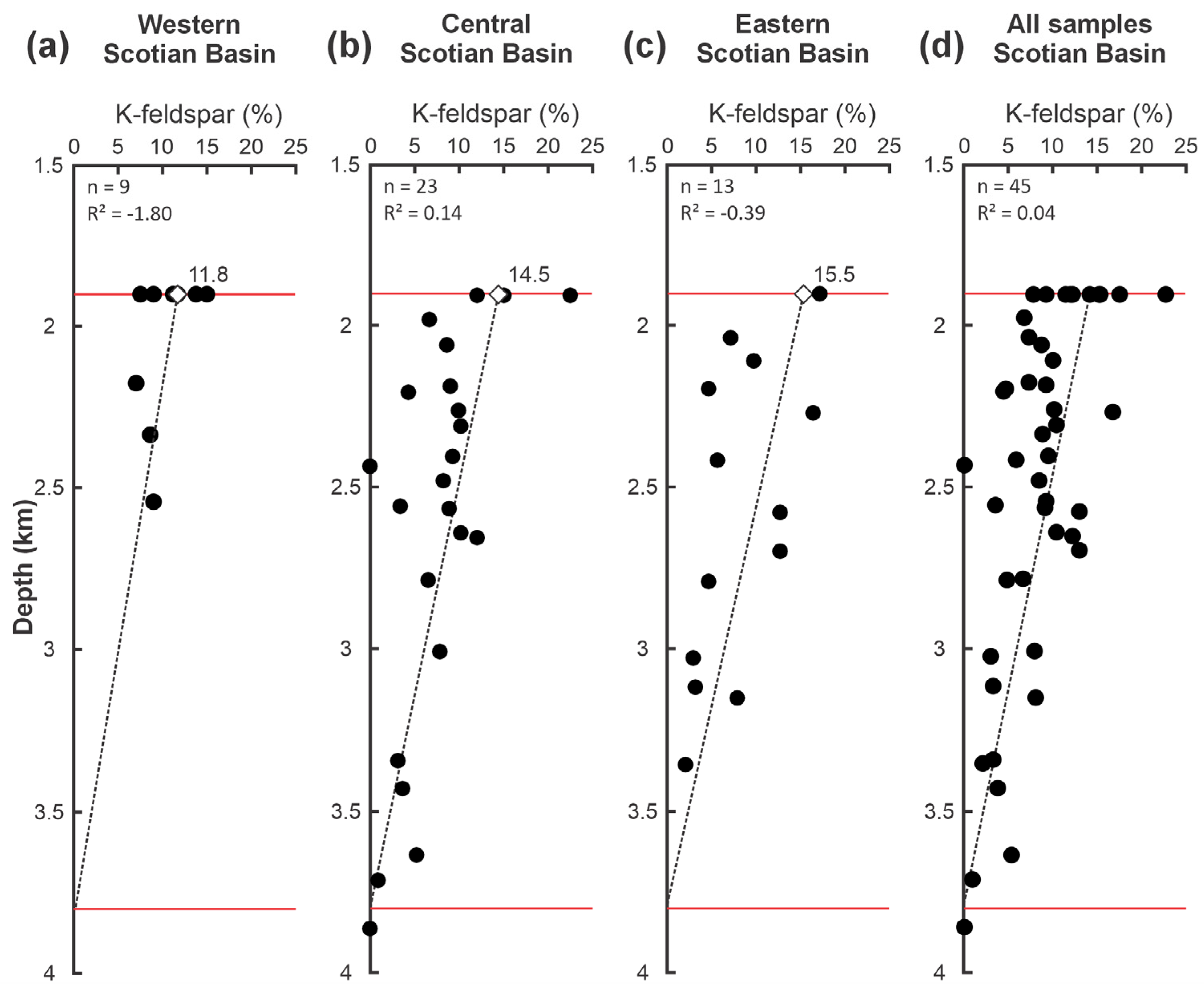
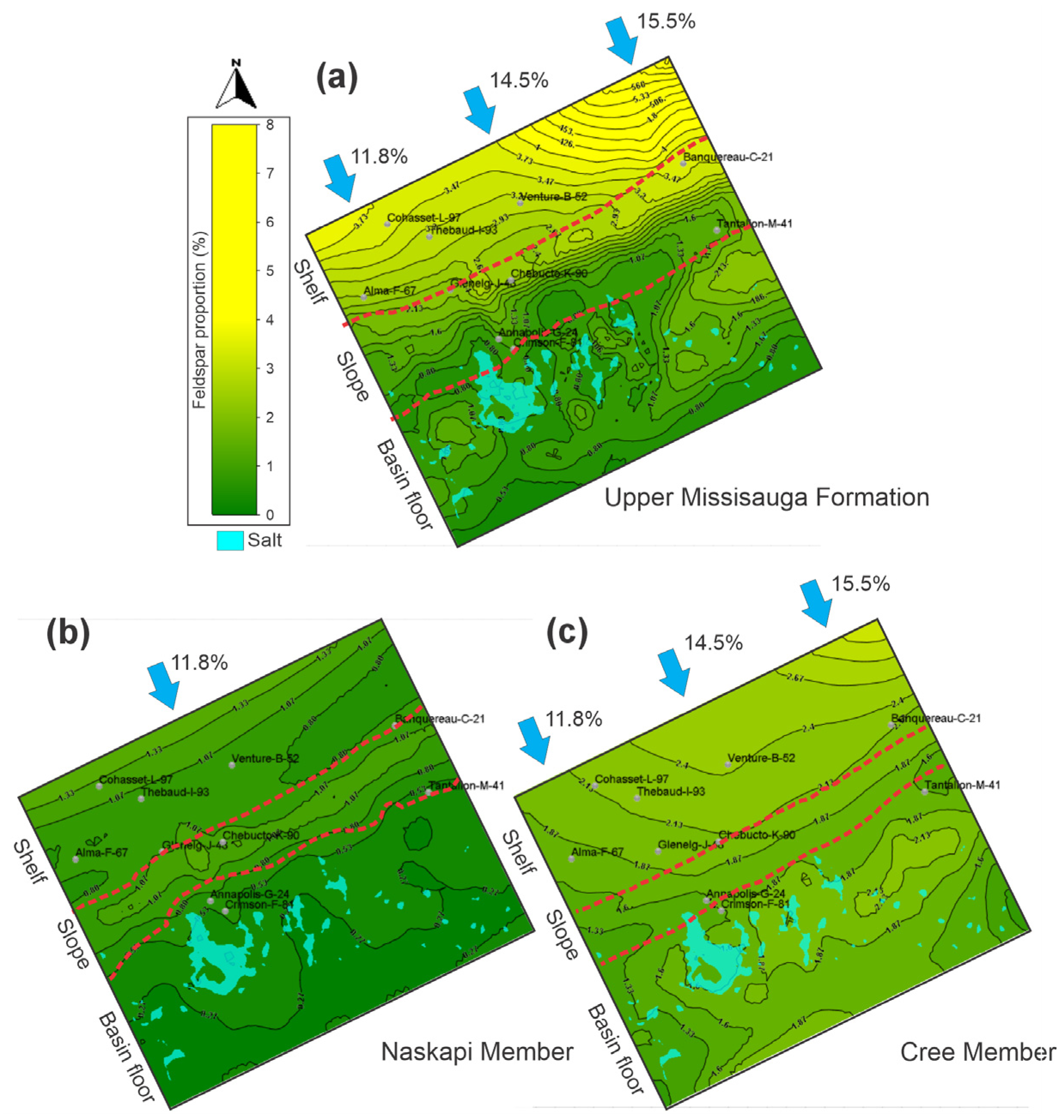
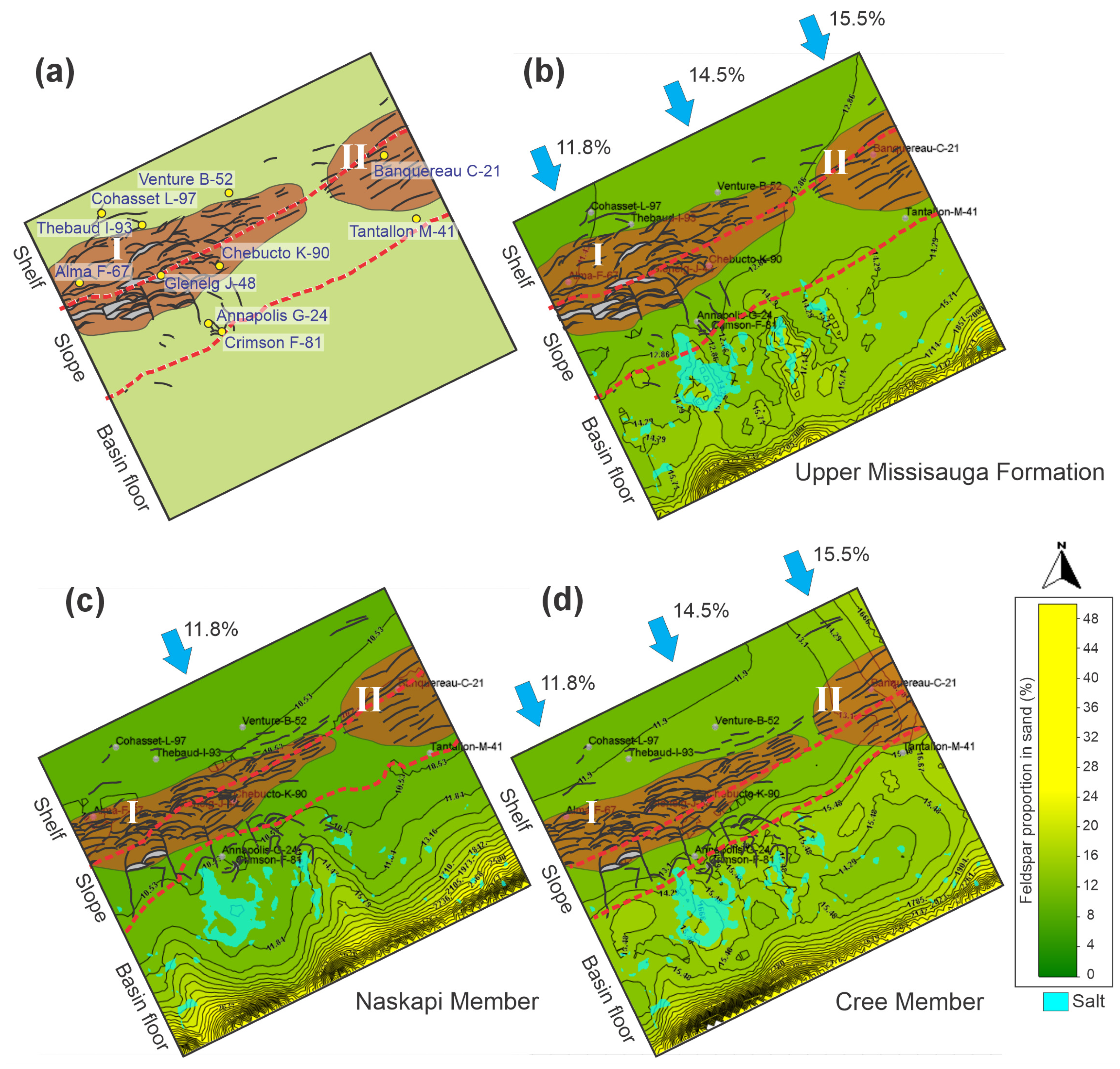
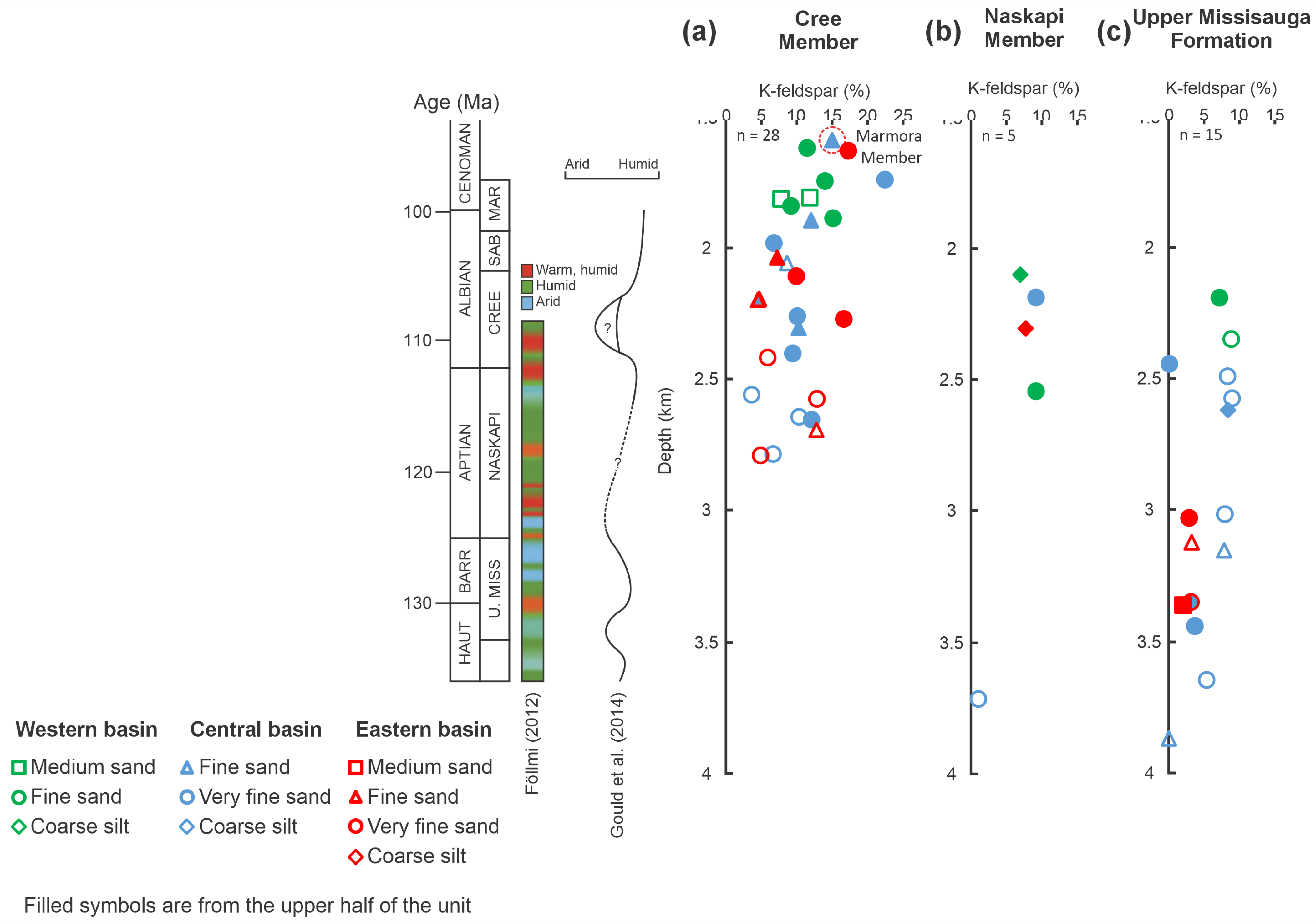
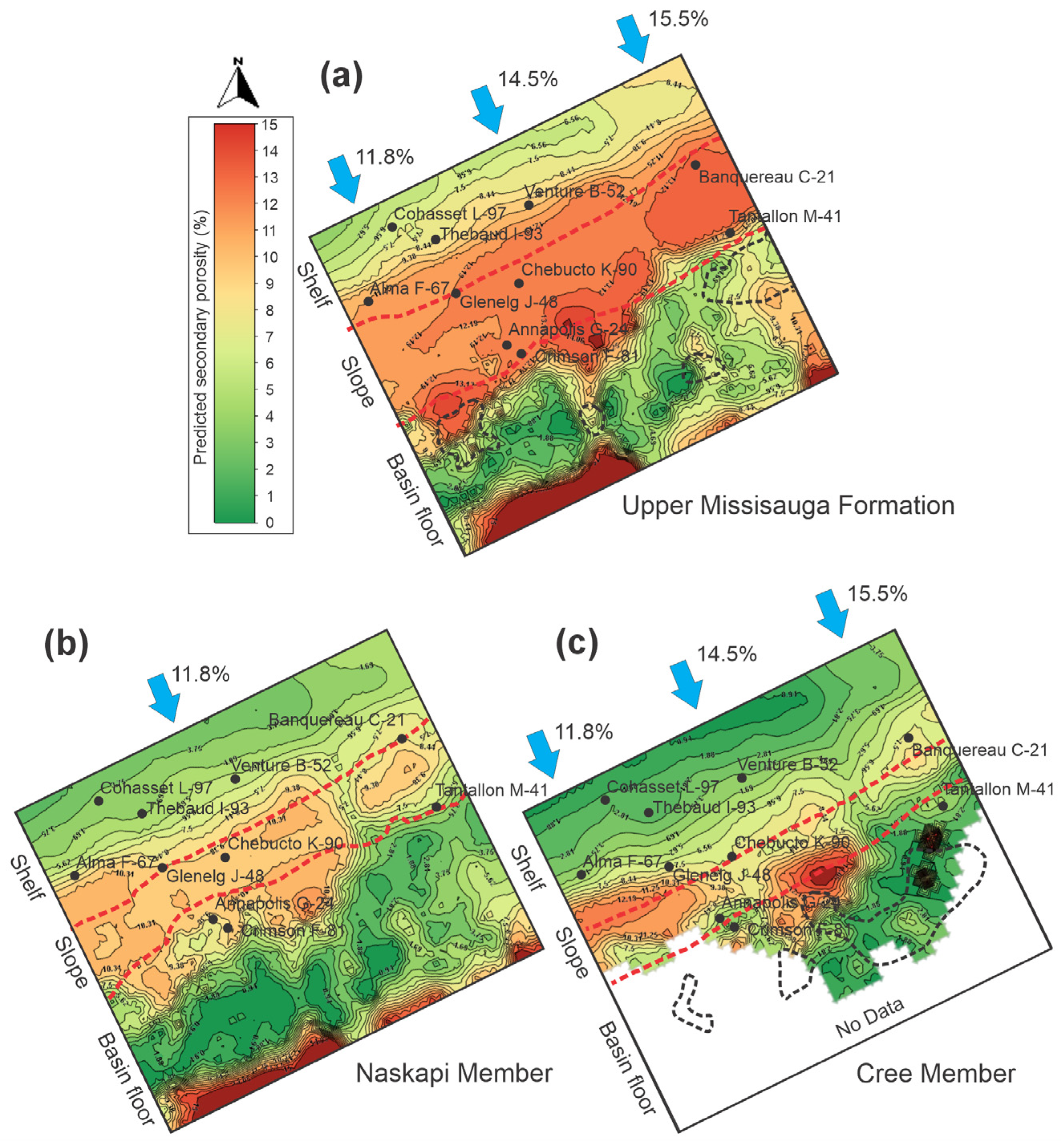

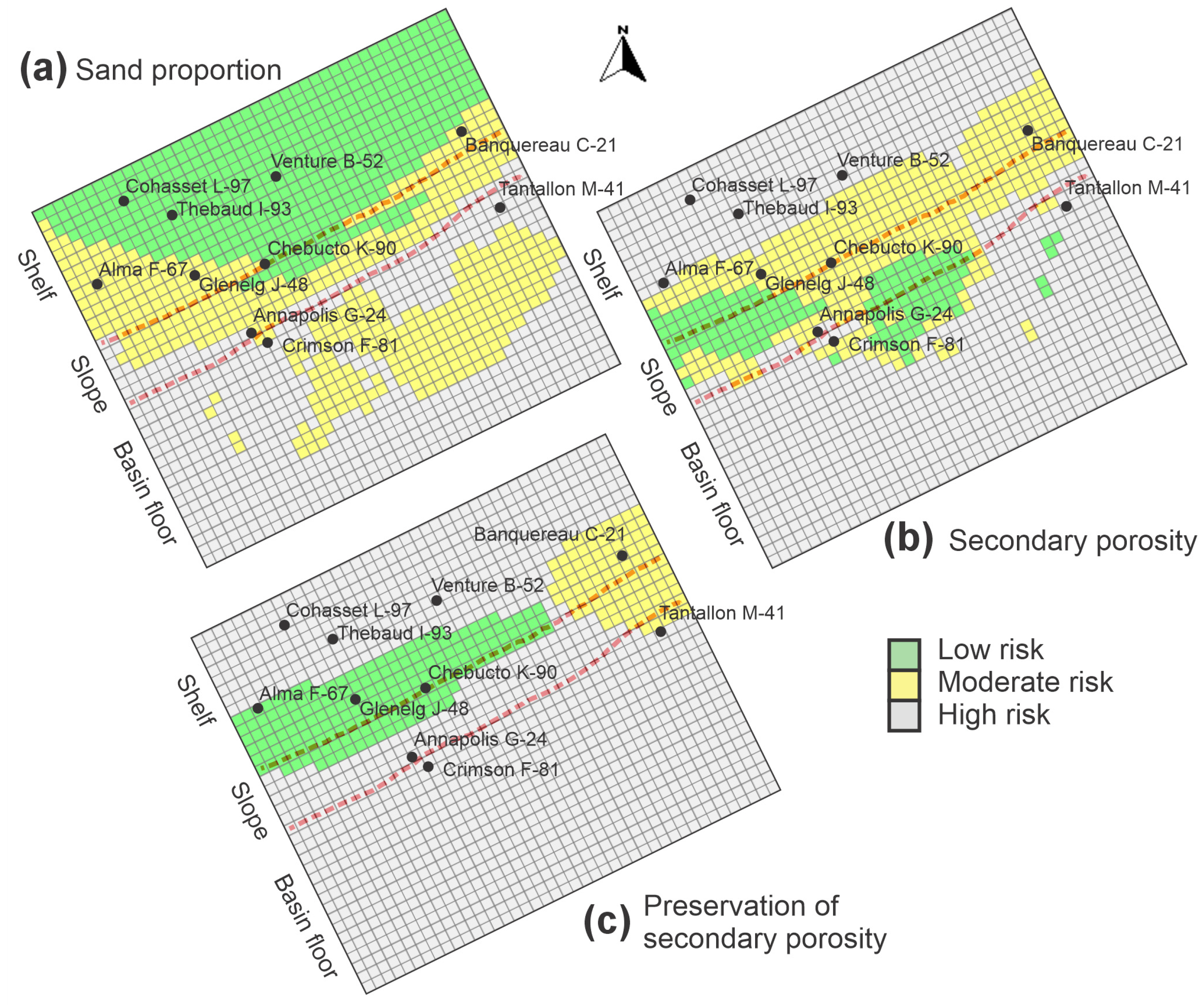

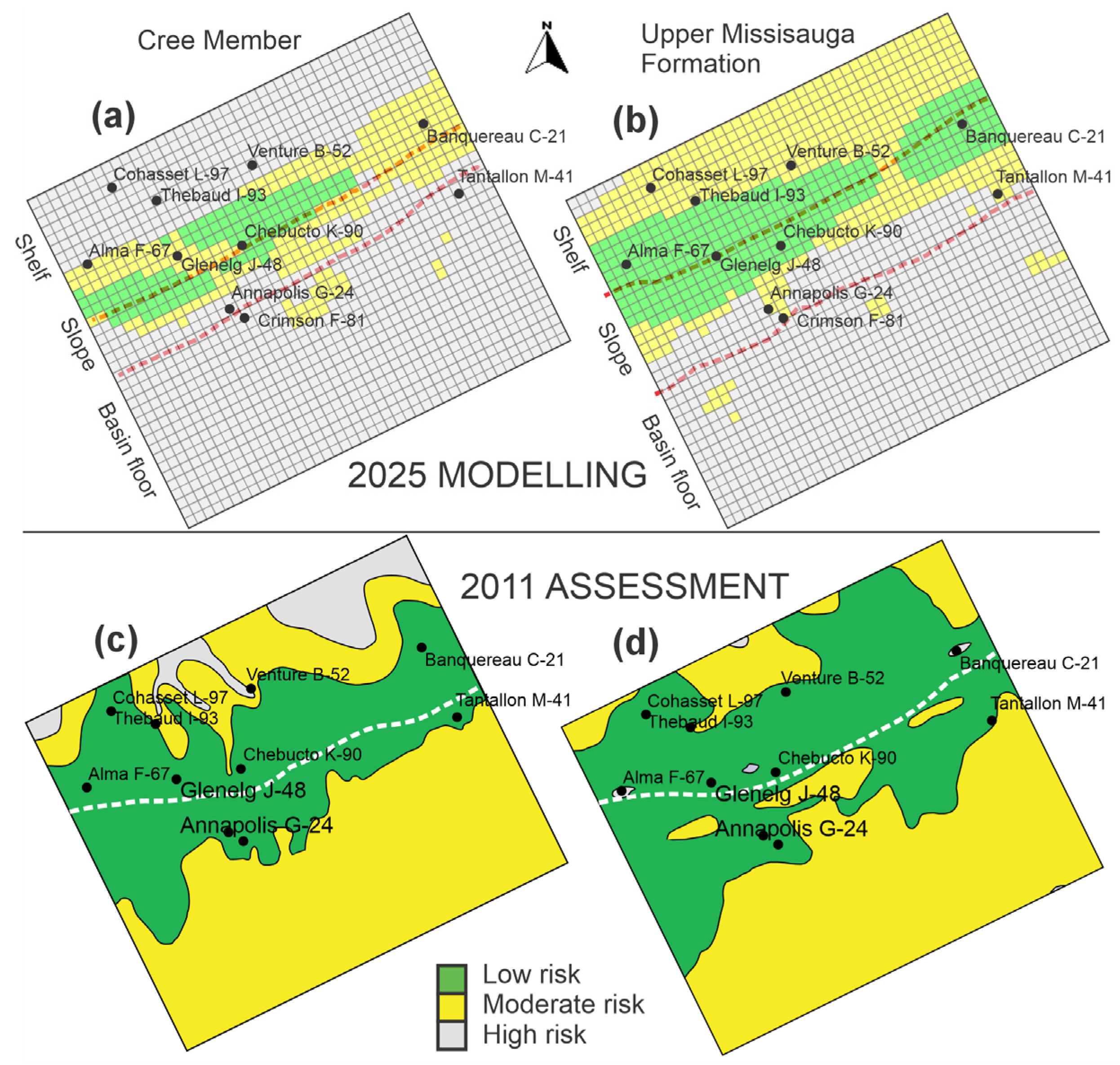
| Sample | Grain size | Composition (Vol%) | |||||||||||||||
|---|---|---|---|---|---|---|---|---|---|---|---|---|---|---|---|---|---|
| Well | Well No. | Type 1 | Depth (m)2 | Strati-Graphic Unit | Reg-ion | Mean Grain Size (µm) | Cut-off 3 | Difference (Qz–Kfs) | Number of Grains Counted | Qz | Kfs | Plag | Total Feld-Spar | ||||
| Qz | Kfs | µm | % | Qz | Kfs | Total | |||||||||||
| Alma | K-85 | S | 1928 | Cree | West | 73 | 67 | 30 | 6 | 8 | 434 | 74 | 508 | 88.4 | 9.1 | 2.6 | 11.6 |
| Alma | K-85 | S | 1971.9 | Cree | West | 75 | 65 | 30 | 10 | 14 | 252 | 62 | 314 | 80.7 | 15.1 | 4.2 | 19.3 |
| Alma | K-85 | S | 2633 | Naskapi | West | 69 | 66 | 30 | 3 | 4 | 366 | 65 | 431 | 84.8 | 9.1 | 6.2 | 15.2 |
| Chippewa | G-67 | S | 1718.8 | Cree | East | 121 | 108 | 63 | 13 | 10 | 245 | 72 | 317 | 81.2 | 17.2 | 1.6 | 18.8 |
| Chippewa | G-67 | S | 2283.6 | Cree | East | 127 | 122 | 63 | 5 | 4 | 400 | 25 | 425 | 94. 9 | 4.6 | 0.5 | 5.1 |
| Cohasset | D-42 | S | 1684.02 | Cree | West | 73 | 72 | 30 | 2 | 2 | 273 | 49 | 322 | 86.5 | 11.3 | 2.2 | 13.5 |
| Cohasset | D-42 | S | 1813.26 | Cree | West | 85 | 76 | 30 | 9 | 11 | 250 | 60 | 310 | 82. 5 | 13.9 | 3.7 | 17.6 |
| Cohasset | L-97 | S | 2150.1 | Naskapi | West | 60 | 51 | 30 | 9 | 15 | 282 | 27 | 309 | 91.6 | 6.9 | 1.5 | 8.5 |
| Cohasset | L-97 | S | 2228.7 | U. Miss | West | 117 | 92 | 50 | 25 | 21 | 280 | 21 | 301 | 89.3 | 7.1 | 3.5 | 10.7 |
| Cohasset | L-97 | S | 2386.9 | U. Miss | West | 106 | 93 | 50 | 13 | 12 | 281 | 45 | 326 | 90.6 | 8.7 | 0.7 | 9. 5 |
| Glenelg | E-58 | P | 3443.86 | U. Miss | Central | 76 | 71 | 30 | 5 | 7 | 266 | 50 | 316 | 90.5 | 3.2 | 6.3 | 9.5 |
| Glenelg | E-58 | P | 3532.08 | U. Miss | Central | 168 | 133 | 30 | 36 | 21 | 272 | 46 | 318 | 92. 9 | 3.7 | 3.4 | 7.1 |
| Glenelg | E-58A | P | 3737.9 | U. Miss | Central | 70 | 68 | 30 | 2 | 2 | 291 | 39 | 330 | 89.6 | 5.3 | 5.1 | 10.4 |
| Glenelg | J-48 | S | 2365 | Cree | Central | 78 | 68 | 30 | 10 | 12 | 265 | 41 | 306 | 82.4 | 9.9 | 7.7 | 17.6 |
| Glenelg | J-48 | S | 2507 | Cree | Central | 122 | 113 | 50 | 9 | 7 | 274 | 45 | 319 | 87.4 | 9.3 | 3.4 | 12.6 |
| Glenelg | J-48 | S | 2758 | Cree | Central | 72 | 60 | 40 | 12 | 16 | 256 | 57 | 313 | 85.3 | 11.9 | 2. 8 | 14.7 |
| Glenelg | J-48 | S | 2890 | Cree | Central | 89 | 76 | 30 | 13 | 14 | 262 | 58 | 320 | 87.4 | 6.5 | 6.1 | 12.6 |
| Glenelg | J-48 | S | 3970 | U. Miss | Central | 130 | - | 30 | - | - | 306 | 0 | 306 | 97.3 | 0.0 | 2. 7 | 2. 7 |
| Kegeshook | G-67 | P | 1902.3 | Cree | West | 258 | 218 | 30 | 40 | 16 | 274 | 87 | 361 | 88.2 | 11.8 | 3.6 | 15.4 |
| Kegeshook | G-67 | P | 1906.36 | Cree | West | 325 | 280 | 30 | 45 | 14 | 244 | 85 | 329 | 90.2 | 7.6 | 2.2 | 9.8 |
| Missisauga | H-54 | S | 1864.46 | Cree | Central | 106 | 97 | 30 | 9 | 9 | 220 | 90 | 310 | 74. 7 | 22.4 | 3.0 | 25.3 |
| Missisauga | H-54 | S | 2182.34 | Cree | Central | 154 | 118 | 50 | 36 | 23 | 256 | 64 | 320 | 90.2 | 8.6 | 1.3 | 9.8 |
| Missisauga | H-54 | S | 2310.07 | Naskapi | Central | 88 | 68 | 30 | 20 | 23 | 272 | 52 | 324 | 89.6 | 9.1 | 1.4 | 10.4 |
| Missisauga | H-54 | S | 2557.27 | U. Miss | Central | 134 | - | 30 | - | - | 304 | 0 | 304 | 99.9 | 0.0 | 0.1 | 0.1 |
| Missisauga | H-54 | S | 2603.29 | U. Miss | Central | 87 | 74 | 30 | 12 | 14 | 281 | 60 | 341 | 90.6 | 8.3 | 1.2 | 9.4 |
| Missisauga | H-54 | S | 2689.25 | U. Miss | Central | 110 | 92 | 30 | 19 | 17 | 249 | 54 | 303 | 89.6 | 8.9 | 1.5 | 10.4 |
| N. Banquereau | I-93 | P | 3469.27 | U. Miss | East | 413 | 380 | 100 | 34 | 8 | 297 | 28 | 325 | 96.6 | 2.0 | 1.4 | 3.4 |
| N. Triumph | G-43 | P | 3811.53 | Naskapi | Central | 76 | 64 | 30 | 13 | 16 | 340 | 12 | 352 | 96.3 | 0.9 | 2.8 | 3.7 |
| Onondaga | B-96 | S | 2700.53 | U. Miss | Central | 60 | 59 | 30 | 2 | 3 | 280 | 42 | 322 | 89.2 | 8.4 | 2.5 | 10.8 |
| Peskowesk | A-99 | S | 2395 | Naskapi | East | 47 | 44 | 20 | 3 | 6 | 268 | 39 | 307 | 90.7 | 7.7 | 1.6 | 9.3 |
| Sable Island | 2H-58 | P | 1600.27 | Marmora | Central | 155 | 152 | 30 | 3 | 2 | 251 | 70 | 321 | 84.8 | 14.9 | 0.3 | 15.2 |
| Sable Island | 5H-58 | P | 1903.66 | Cree | Central | 149 | 144 | 30 | 5 | 4 | 266 | 57 | 323 | 87.0 | 12.0 | 1.1 | 13.0 |
| Sauk | A-52 | S | 2118.97 | Cree | East | 137 | 131 | 50 | 6 | 4 | 265 | 71 | 336 | 91.0 | 7.1 | 1.9 | 9.0 |
| Sauk | A-52 | S | 2189.99 | Cree | East | 95 | 103 | 30 | ™8 | ™9 | 229 | 78 | 307 | 85.6 | 9.8 | 4.6 | 14.4 |
| Sauk | A-52 | S | 2350.01 | Cree | East | 104 | 90 | 30 | 14 | 14 | 201 | 106 | 307 | 79.9 | 16.5 | 3.6 | 20.1 |
| Sauk | A-52 | S | 2498.14 | Cree | East | 67 | 59 | 30 | 8 | 12 | 249 | 74 | 323 | 89.9 | 5.7 | 4.3 | 10.1 |
| Sauk | A-52 | S | 2656.94 | Cree | East | 97 | 88 | 30 | 9 | 10 | 248 | 88 | 336 | 86.4 | 12.8 | 0.9 | 13.7 |
| Sauk | A-52 | S | 2776.73 | Cree | East | 200 | 187 | 30 | 13 | 6 | 263 | 78 | 341 | 86.4 | 12. 8 | 0.9 | 13.7 |
| Sauk | A-52 | S | 2871.52 | Cree | East | 67 | 61 | 30 | 6 | 9 | 269 | 35 | 304 | 93.5 | 4.7 | 1.8 | 6.5 |
| Sauk | A-52 | S | 3107.13 | U. Miss | East | 111 | 83 | 30 | 28 | 25 | 290 | 42 | 332 | 95.1 | 2.9 | 1.9 | 4.9 |
| Sauk | A-52 | S | 3199.79 | U. Miss | East | 196 | 158 | 50 | 38 | 19 | 273 | 32 | 305 | 96.0 | 3.2 | 0.7 | 4.0 |
| Sauk | A-52 | S | 3233.01 | U. Miss | East | 160 | 138 | 50 | 23 | 14 | 276 | 31 | 307 | 91.1 | 7.9 | 0.9 | 8.9 |
| Venture | D-23 | S | 2026 | Cree | Central | 97 | 85 | 30 | 12 | 12 | 245 | 57 | 302 | 92.3 | 6.7 | 1.1 | 7.7 |
| Venture | D-23 | S | 2254 | Cree | Central | 66 | 58 | 30 | 8 | 11 | 255 | 48 | 303 | 92.0 | 4.4 | 3.6 | 8.0 |
| Venture | D-23 | S | 2357 | Cree | Central | 158 | 146 | 50 | 12 | 8 | 285 | 30 | 315 | 86. 9 | 10.2 | 2. 9 | 13.1 |
| Venture | D-23 | S | 2606 | Cree | Central | 116 | 93 | 30 | 23 | 19 | 273 | 48 | 321 | 94.7 | 3. 5 | 1.8 | 5.3 |
| Venture | D-23 | S | 2690 | Cree | Central | 104 | 99 | 50 | 5 | 4 | 248 | 71 | 319 | 86. 9 | 10.2 | 2. 9 | 13.1 |
| Venture | D-23 | S | 3055 | U. Miss | Central | 83 | 70 | 30 | 13 | 16 | 268 | 46 | 314 | 88.7 | 7.8 | 3.4 | 11.3 |
| Grain Size Fraction | Mean Grain Size Difference (%) | Mean Grain Size (μm) | |
|---|---|---|---|
| Qz | Kfs | ||
| Clay | - | 40 | - |
| Silt | - | 60 | - |
| Very fine sand | 9 | 75 | 68 |
| Fine sand | 3 | 200 | 195 |
| Medium sand | 15 | 400 | 341 |
| Coarse sand | - | 650 | 576 |
| Risk Type | Risk Level | ||
|---|---|---|---|
| High | Moderate | Low | |
| * Sand distribution (Cree Member) | <10% | 10–16% | >16% |
| Sand distribution (Upper Missisauga Formation) | <9% | 9–18% | >18% |
| Secondary porosity | <5% | 5–10% | >10% |
| Preservation of secondary porosity | other | II | I |
| Total risk | 3–6 points | 6–8 points | 8 or 9 points |
Disclaimer/Publisher’s Note: The statements, opinions and data contained in all publications are solely those of the individual author(s) and contributor(s) and not of MDPI and/or the editor(s). MDPI and/or the editor(s) disclaim responsibility for any injury to people or property resulting from any ideas, methods, instructions or products referred to in the content. |
© 2025 by the authors and by His Majesty the King in Right of Canada, as represented by the Minister of Natural Resources. Submitted for possible open access publication under the terms and conditions of the Creative Commons Attribution (CC BY) license (https://creativecommons.org/licenses/by/4.0/).
Share and Cite
Sangster, C.; Pe-Piper, G.; Saint-Ange, F.; Piper, D.J.W.; Hawie, N. Predictive Modeling of Reservoir Quality Associated with the Dissolution of K-Feldspar During Diagenesis: Lower Cretaceous, Scotian Basin, Canada. Minerals 2025, 15, 1008. https://doi.org/10.3390/min15101008
Sangster C, Pe-Piper G, Saint-Ange F, Piper DJW, Hawie N. Predictive Modeling of Reservoir Quality Associated with the Dissolution of K-Feldspar During Diagenesis: Lower Cretaceous, Scotian Basin, Canada. Minerals. 2025; 15(10):1008. https://doi.org/10.3390/min15101008
Chicago/Turabian StyleSangster, Christopher, Georgia Pe-Piper, Francky Saint-Ange, David J. W. Piper, and Nicolas Hawie. 2025. "Predictive Modeling of Reservoir Quality Associated with the Dissolution of K-Feldspar During Diagenesis: Lower Cretaceous, Scotian Basin, Canada" Minerals 15, no. 10: 1008. https://doi.org/10.3390/min15101008
APA StyleSangster, C., Pe-Piper, G., Saint-Ange, F., Piper, D. J. W., & Hawie, N. (2025). Predictive Modeling of Reservoir Quality Associated with the Dissolution of K-Feldspar During Diagenesis: Lower Cretaceous, Scotian Basin, Canada. Minerals, 15(10), 1008. https://doi.org/10.3390/min15101008






